I have a wee bit of time and an inkling to do an X’s and O’s post, which I rarely find the time to do. So let’s enjoy it while we can.
The hot thing in college football the past few years has been the RPO (a.k.a. Run-Pass Option), a different take on the old double or triple options that have been run for years. RPOs aren’t new to football, but they did disappear from the mainstream for a little while, and the new-ish emphasis on passing the ball has opened things up for offenses. The RPO discussion really ramped up during the Philadelphia Eagles’ run to the Super Bowl championship in the 2017-2018 season, because the Eagles run a fair number of them.
Hit the jump for more on Shea Patterson and RPOs.
Generally, the response to a team running RPOs is to run man-to-man coverage. The reason is that against zone defenses, individual defenders are easier to isolate, and if they vacate their zone because of a poor read, it leaves miles of space. In man coverage, the man defenders keep their eyes on the receivers and “go wherever he goes,” so eye discipline isn’t as important. If your receiver runs a vertical or a slant in man coverage, you’re supposed to follow him. The end.
But that doesn’t mean man coverage isn’t susceptible to RPOs. They can still be beaten, especially if you have a guy on offense who’s flat-out better than the guy on defense.
So here’s an example of an RPO that Ole Miss ran against Auburn with Shea Patterson behind center. Ole Miss was down 38-3 in the third quarter, so it wasn’t a very competitive game at the time, but the scheme is still important. I’ve drawn it up with the skill guys’ numbers that Michigan could employ:
#2 Shea Patterson
#22 Karan Higdon
#7 Tarik Black
#84 Sean McKeon
#13 Eddie McDoom
#9 Donovan Peoples-Jones
As you can see, Ole Miss (a.k.a. Michigan) is running inside zone to the left. The LT is responsible for the playside end, the LG/C combo on the playside DT up to the playside LB, and the RG/RT combo on the backside DT. Meanwhile, the H-back is going from the frontside of the play to kick out the backside DE.
At the skill positions, the Z is blocking/occupying his man on the playside. Backside, the slot runs a vertical route up the seam, and the X receiver runs a slant. The QB and RB are meshing in the backfield on the zone read.
Here’s the pre-snap setup from Ole Miss:
Auburn defends it by running a scrape exchange with the weakside DE/ILB. A “scrape exchange” is where the DE crashes down to take the RB on the dive, while the backside ILB scrapes outside to defend the C-gap and tackle the QB if the QB keeps the ball.
Above: You can see the DE has crashed inside, while the backside ILB is coming downhill to play C-gap; that ILB is in No Man’s Land because Patterson isn’t going to keep the ball. The kickout block from the H-back (which turns into a log block since the DE crashed) basically means the QB won’t keep, because a kickout block would actually push the DE toward the QB if he kept. You’ll also notice above that the field safety, who started the play 8 yards from the line of scrimmage (LOS) is now 6 yards off the LOS. He bit down to support the run, and the slot receiver (imagine Eddie McDoom) is busy beating the nickel corner to the inside.
If you know anything about football, you know that a defender should never get beaten to the inside in man coverage.
So who screwed up? Well, the field safety screwed up in supporting the run. Why? Because his eyes took him toward the LOS to support the run, which is part of his job. (Remember what I said about the problem with running zone coverage against RPOs?) The nickel corner also screwed up by allowing the inside release, but he should have help from the field safety.
On to the next shot:
Above: That’s the Ole Miss slot receiver catching the ball 30 yards downfield. The slot corner is on his back hip, and the WR left the field safety in the dust by 8 yards.
SO WHAT’S THE TAKEAWAY?
Ole Miss has a more wide open offense than Michigan, but it would probably be a little bit foolish to try to take Patterson (a square peg) and make him Wilton Speight (a round hole). Patterson has the running ability to make teams practice scrape exchanges and to send a safety flying downhill towards zone read action. Nobody would have respected Speight or Brandon Peters to hurt them running the ball. And while Patterson is never going to be a dual-threat guy like Cam Newton or Denard Robinson, he’s quick enough and elusive enough to hurt teams on occasion. Opponents have to respect his running ability.
Furthermore, the Michigan coaching staff knows that Patterson can handle those reads at this level. Patterson had to read one guy after he figured out Auburn was running man coverage:
- If the safety attacks the LOS, throw the vertical.
- If the safety sits or bails deep, hand off the ball.
Keep in mind, too, that Patterson could have hit the X receiver running the slant, too, if he knew that guy could win inside.
Michigan has coaches in place who like inside zone, who have coached in spread-to-run offenses, and who have had mobile quarterbacks. Offensive line coach Ed Warinner coached at Ohio State with Urban Meyer. Wide receivers coach Jim McElwain is a pro-style spread guy. Jim Harbaugh used Alex Smith and Colin Kaepernick very effectively in San Francisco. These types of play designs could be very easily employed at Michigan, and they should be, because it takes advantage of the talent Michigan has on the roster.
WHAT ELSE COULD MICHIGAN RUN HERE?
Michigan/Ole Miss/any team could run this thing that Michigan fans have learned to loathe against Michigan’s aggressive, man-to-man defense:
That’s the Smash Fade (a.k.a. “slot fade”), which is effectively the same thing as what Ole Miss ran in the play above, just with a slightly different attack. Instead of a slant, the X is running a hitch, and the slot guy is running a fade instead of a seam route. The fade is a tougher throw, so you might as well run a seam route if the field safety is going to vacate and you can get that inside release.
NOTE: If I plan to have someone run a slot fade rather than a seam route, I might change my personnel a little bit to put Tarik Black or Donovan Peoples-Jones in the slot to create a bigger target for the fade route.
The video below should be queued up to the RPO diagrammed above. Happy reading/watching!
You need to login in order to vote

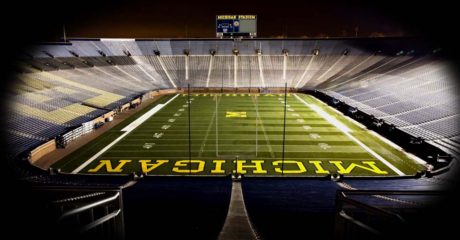
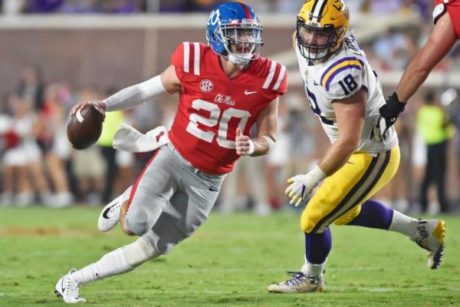
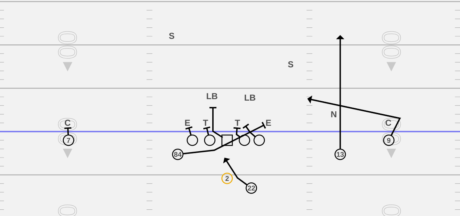
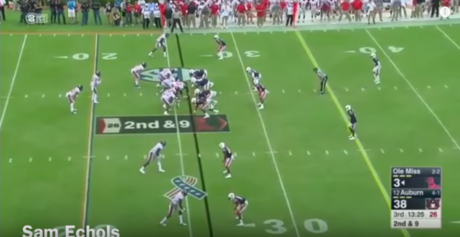
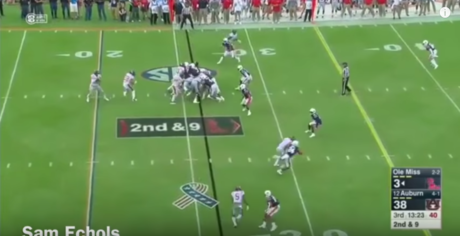
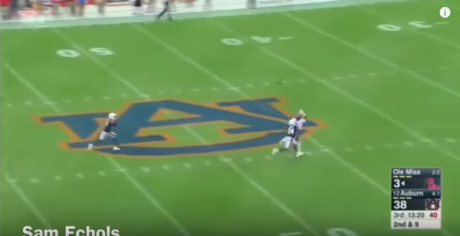
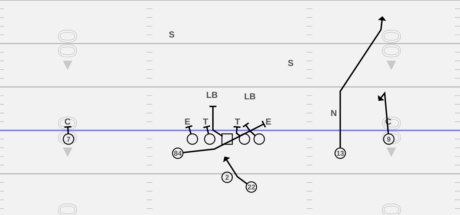
First of all, nice post.
Secondly, the slot receiver had his guy beat, but not by much, his guy was on his shoulder running stride for stride which means that Patterson had to deliver a real good ball. At minimum, the ball had to be away. The pass you need here is exactly the pass that O’Korn couldn’t make … ok, ok … among others. Which is why, despite the fact that he was a superior athlete, he couldn’t get past Speight and then sunk us when Speight went down. People are going to watch this team run offense that it had before and think that we’ve “opened up” or some other term. The truth is that we just didn’t have the Quarterbacking you need to run the stuff. .
You need to login in order to vote
The slot guy didn’t have his guy beat by much, but the nice thing about this play is that those seam routes are the types of throws the QB loves most. If there’s no safety over the top, all you have to do is drop it in there and lead your receiver. That’s the type of throw those QBs have been practicing in the back yard since they were 8 years old. It doesn’t have anything to do with timing or fitting the ball in between two defenders. It’s just pitch-and-catch.
You need to login in order to vote
They can love em all day long, but they still have to get it there. And again, in this particular case, away is fine … maybe better because the guy is trapped on a shoulder, but the QB has to get it up the seem without it going over his head. I don’t believe that O’Korn was ever really sure just exactly where it was going and Speight can’t run this action because while he was not a statue, he sure wasn’t a threat to run.
My point is that this stuff ain’t new. We ran a bizarre little sprintout RPO when I was in high school. It also isn’t new to Harbaugh as you pointed out. While this particular play might be new around here post RR, and have some twists, it’s been around too. The key to making it go is the right QB. With the QBs we’ve run with that could play since Harbaugh got here, we haven’t had that kind of guy. Then we had O’Korn.
Can you imagine if Harbaugh had had Denard?
Sigh!!!
You need to login in order to vote
This is great, informative and most importantly, easily decipherable. I have a pet peeve about chalk talkers who use way to much football idiom and lose me along the way.
Also, this is very encouraging regarding Michigan’s potential with Patterson.
Regarding your last thought about having a bigger target for the slot fade, how about Gentry, Eubanks, or even Collins?
You need to login in order to vote
Thanks.
The reason I don’t like using TE types for a lot of RPO stuff is that it involves misdirection, which gives you a step on the defense. If you put a slower guy out there who’s being covered by a safety, for example, the safety might have the makeup speed to gain back that extra step that someone like Eubanks might have gained in the first place. There are some times where an RPO might work with a TE-type guy. For example, Penn State ran some with Mike Gesicki where it looked like he was going to arc release to block an OLB (or SS?) and then released upfield for a TD.
You need to login in order to vote
There are a couple RPOs with Gesicki at 2:25 and 3:25 of this video that I think fit better with running RPOs with tight end types:
https://www.youtube.com/watch?v=nneCOB3AQVs
You need to login in order to vote
Thanks Thunder! I was really enjoying it until I pictured yet another fade to mcdoom…
“NOTE: If I plan to have someone run a slot fade rather than a seam route, I might change my personnel a little bit to put Tarik Black or Donovan Peoples-Jones in the slot to create a bigger target for the fade route”
You need to login in order to vote
If it makes you feel any better, I think McDoom is the type of receiver who should benefit most from Shea Patterson’s arrival. Not only can he be used on RPOs, but McDoom is the type of player who can pop open deep and make things happen after the catch when Patterson scrambles.
You need to login in order to vote
Agree. Let’s hope he’s lived with a jugs machine this off-season
You need to login in order to vote
Very nice write up. Useful for those of us who are not as savvy with X’s and O’s. Thanks!
You need to login in order to vote